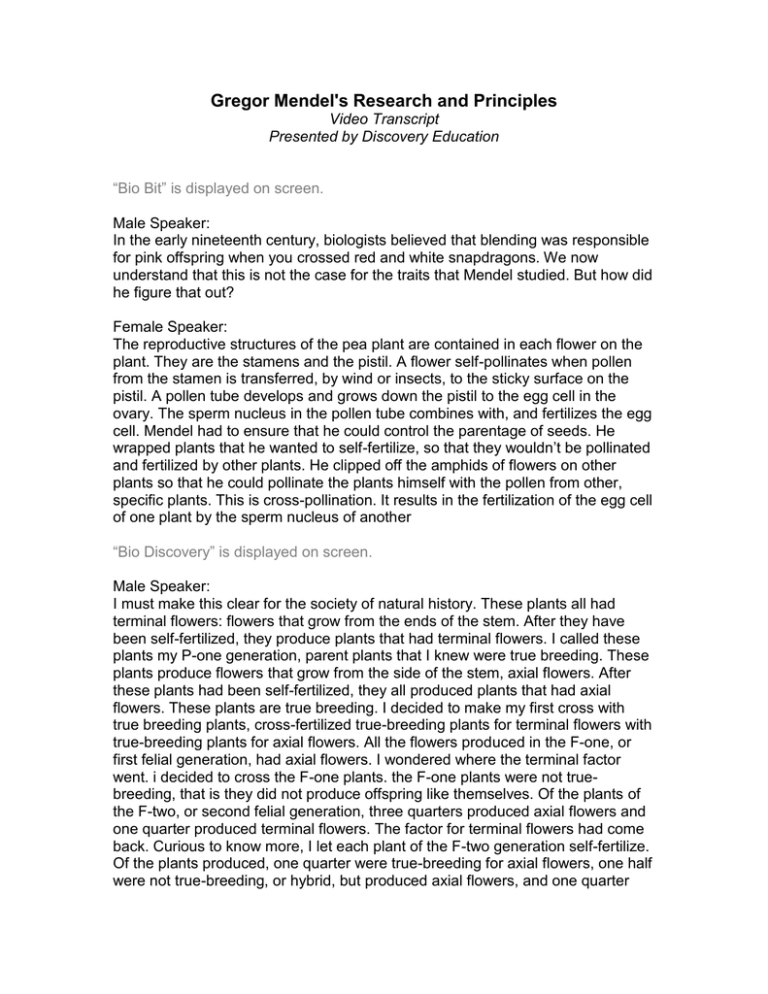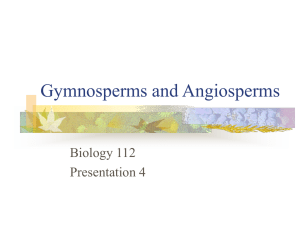
Gregor Mendel's Research and Principles
Video Transcript
Presented by Discovery Education
“Bio Bit” is displayed on screen.
Male Speaker:
In the early nineteenth century, biologists believed that blending was responsible
for pink offspring when you crossed red and white snapdragons. We now
understand that this is not the case for the traits that Mendel studied. But how did
he figure that out?
Female Speaker:
The reproductive structures of the pea plant are contained in each flower on the
plant. They are the stamens and the pistil. A flower self-pollinates when pollen
from the stamen is transferred, by wind or insects, to the sticky surface on the
pistil. A pollen tube develops and grows down the pistil to the egg cell in the
ovary. The sperm nucleus in the pollen tube combines with, and fertilizes the egg
cell. Mendel had to ensure that he could control the parentage of seeds. He
wrapped plants that he wanted to self-fertilize, so that they wouldn’t be pollinated
and fertilized by other plants. He clipped off the amphids of flowers on other
plants so that he could pollinate the plants himself with the pollen from other,
specific plants. This is cross-pollination. It results in the fertilization of the egg cell
of one plant by the sperm nucleus of another
“Bio Discovery” is displayed on screen.
Male Speaker:
I must make this clear for the society of natural history. These plants all had
terminal flowers: flowers that grow from the ends of the stem. After they have
been self-fertilized, they produce plants that had terminal flowers. I called these
plants my P-one generation, parent plants that I knew were true breeding. These
plants produce flowers that grow from the side of the stem, axial flowers. After
these plants had been self-fertilized, they all produced plants that had axial
flowers. These plants are true breeding. I decided to make my first cross with
true breeding plants, cross-fertilized true-breeding plants for terminal flowers with
true-breeding plants for axial flowers. All the flowers produced in the F-one, or
first felial generation, had axial flowers. I wondered where the terminal factor
went. i decided to cross the F-one plants. the F-one plants were not truebreeding, that is they did not produce offspring like themselves. Of the plants of
the F-two, or second felial generation, three quarters produced axial flowers and
one quarter produced terminal flowers. The factor for terminal flowers had come
back. Curious to know more, I let each plant of the F-two generation self-fertilize.
Of the plants produced, one quarter were true-breeding for axial flowers, one half
were not true-breeding, or hybrid, but produced axial flowers, and one quarter
were true-breeding for terminal flowers. Clearly, the hybrid plants contained
factors for both characteristics but produced only axial flowers. The factor for
terminal flowers had not disappeared, it was only masked. When it combined
with a plant that had a similar factor, it produced offspring that had terminal
flowers. To explain these results, I believed that the hereditary factors must occur
in pairs, these factors must separate in the parent plant, and then each parent
must give one factor, randomly, to the next generation. I will call these factors
either dominant or recessive. The dominant factor masks the recessive factor. In
this case, the true-breeding axial plants have two dominant factors: capital A,
capital A. The true-breeding terminal plants have two recessive factors, small a,
small A, so the trait can show. The hybrid plant has one dominant factor, capital
A, and one recessive factor, small A, but only the dominant factor, axial flower,
shows.
Produced by:
Discovery Education
www.discoveryeducation.com
Transcribed August 2011
©2011 Connections Education LLC. All rights reserved.






